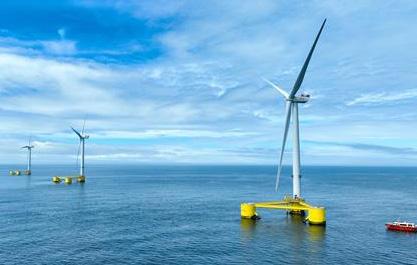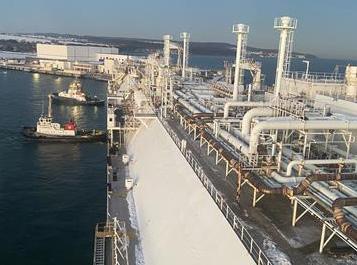
5 minute read
Back in the fold
BACK IN THE FOLD: UK RE-ENGAGES WITH EU
Three years after leaving because of Brexit, the UK has re-joined an EU organisation to develop offshore wind in the North Sea
The UK has signed a Memorandum of Understanding with the European Commission and members of the North Sea Energy Cooperation (NSEC) to ‘re-engage’ following the departure of the UK from the EU.
The NSEC, which is comprised of representatives of nine EU countries, is a facilitator for coordinating the development of offshore wind and grids in the North Sea, the Irish Sea and the Celtic Sea.
With the dire energy situation facing all nations, the move is aiming to strengthen energy security and provide affordable energy on the continent. ”To strengthen its energy security and ensure affordable electricity for European families and businesses, EU countries now want 110 GW of offshore wind by 2030,” says the association WindEurope. ”And the UK wants another 50 GW. They are and will remain the leading country in Europe on offshore wind. It’s a no-brainer that the EU and UK collaborate on how they build out and connect their offshore wind farms. Both sides get this and want to collaborate closely. Hence the MoU.”
“As the UK’s offshore wind fleet continues to expand rapidly in the North Sea, opportunities to work even closer with our European colleagues on sharing investments in infrastructure, building more interconnectors and protecting biodiversity will benefit everyone by enabling us to scale up on vital new deployment,” said RenewableUK CEO Dan McGrail. ”This will enable us to boost energy security in the UK and across Europe at a time when we need to move away from expensive imported gas as fast as possible.”
Cordi O’Hara, President of National Grid Ventures, said: “We warmly welcome the UK re-engaging with NSEC, because we need all North West European countries working together to harness the full clean energy potential of the North Sea.
“We now look forward to working with our partners to develop the next generation of hybrid projects, which will help to accelerate offshore wind while mitigating the impact of infrastructure on coastal communities. But none of us can do this alone, so we must build on the strong platforms we have established to deliver an integrated offshore grid that will maximise benefits for consumers across Europe.”
8 NSEC-UK
Memorandum of Understanding
Portugal enters the floating wind race
Portugal has announced it will set up special offshore zones to unlock the country’s potential for floating wind installations.
The Technological Free Zones were announced at a conference in Lisbon held by WavEC Offshore Renewables, a private, non-profit offshore marine energy research and consultancy association based in Lisbon.
CEO Marco Alves said the zones would ’provide a further springboard for floating wind developers, unlocking pre-consented areas with active grid connections and reduced regulatory processes’. ”This is an exceptionally exciting time for the marine energy space. It was clear from our conference, which centred around offshore wind innovations across Iberia, that floating wind in particular will play a significant role in the future energy

Photo courtesy of Principle Power
8 WindFloat Atlantic
transition. In recognition of this opportunity, Portugal is now planning specially adapted Technological Free Zones to turbo-charge development.”
Portugal joins a small group of countries which have launched similar regimes including Australia, Canada, India, Singapore and the UK.
With national plans to install 10GW of offshore wind capacity by 2030, the measures aim to unlock a massive 131GW offshore wind resources, 90% of which is in deep waters and dependent on floating foundations.
Portugal has already hosted several ocean energy demonstrations, with the WindFloat Atlantic project now powering 60,000 homes. Further plans are afoot with Welsh marine energy developer Marine Power Systems to deploy a unique modular floating offshore wind platform, PelaFlex.
CorPower Ocean’s flagship HiWave-5 wave energy demonstration project is also preparing to launch at the Aguçadoura test site.
Meanwhile, Spain’s recently approved Offshore Wind Roadmap aims to install 3GW by 2030, which is all likely to be floating platforms.
NEW PARTNERSHIP WILL EXPLORE H2 ENGINE
Netherlands-based energy firm Eneco has announced its new partnership with Windcat Workboats will be centred around Windcat’s dual-fuel hydrogen technology as a first step towards using the fuel in future vessels

The first vessel to operate under the partnership, Windcat 32, began work on the first day of this year, 2023.
Windcat managing director Willem van der Well says it was the firm’s hydrogen engine that attracted Eneco to the partnership, since both companies are aiming for emissionsfree operations.
“Windcat 32, the vessel used for this charter, is fuel-efficient and will be used for the safe transport of technicians offshore,” he said. “The vessel will be customised to Eneco’s needs, amongst others by the installation of an IMO Tier III engine. This engine uses a SCR (Selective Catalytic Reduction) system which radically reduces NOx emissions.
“The vessel will operate from IJmuiden and provide access
to Eneco’s offshore wind farms: Prinses Amalia Windpark, Luchterduinen and Hollandse Kust Noord.”
“Windcat will be an important partner in decarbonizing our offshore logistics and delivering on our ambition becoming climate neutral in 2035,” said Eneco lead asset manager Offshore Wind Renzo Schildmeijer.
8 Windcat 32 for
Eneco
Boluda expands offering with FSRU services
The first German Floating Storage and Regasification Unit (FSRU) to be used at a floating LNG terminal in Lubmin is being served by Boluda Towage with four powerful tugs.
VB Luca, VB Fritzi, VB Ivy and VB Henny, in a range of 60.2 tonnes up to 79 tonnes with bollard pull and firefighting capabilities, will be also be used tow shuttle tankers in and out of the port, which is too small to accommodate big LNG tankers. A storage tanker will be anchored outside the port and three smaller ones will provide the shuttling operations with Boluda’s tugs to and from the FSRU Neptune inside the port, intensive simulations for which have already been carried out and approved by the port’s authorities.
An existing gas pipeline at the port, which is being developed by Deutsche ReGas, will allow for a quick connection, Boluda says. ”The presence in the port is a further step towards strengthening and expanding the activities of Boluda Towage Division in northwest Europe and the Baltic Sea region,” the company says.
Deutsche ReGas has said it expects the Lubmin facility to deliver about 4.5 billion m3 of LNG a year.

8 Boluda Towage at the Port of Lubmin



